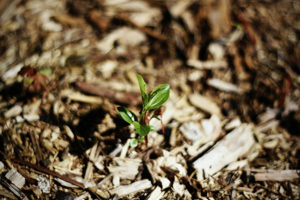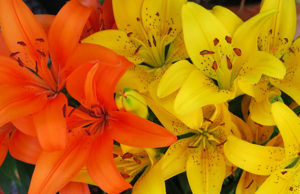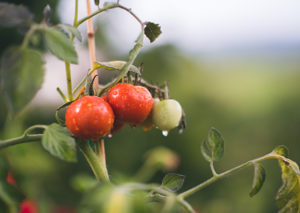With spring comes the opportunity many of us have been waiting for all winter: getting our hands dirty while beautifying our outdoor spaces. With every seed or bulb we plant – and every lawn or pest product we choose – comes the opportunity to not only perk up our yards but also keep our pets safe. Unbeknownst to many pet owners, many of the most common plants and products on the market can be toxic to our curious cats and dogs. Fortunately, a little knowledge goes a long way, and a myriad of safe options exist, allowing both your yard and your pets to flourish.
Avoid these Potentially Toxic Flowers
- Lilies: These are popular garden flowers simply because they look pretty. However, those pretty flowers are extremely dangerous, especially to cats when ingested. There are also certain types of lilies that can be harmful to dogs.
- Daffodils: These brilliant flowers can be highly toxic both to dogs and cats. Any part of this plant can be poisonous to your pet, but the bulbs are the most dangerous part.
- Tulip: When your pet eats a tulip, or worse the bulb of a tulip, the symptoms show up within just a few hours. The bulb is the worst part of the plant, as it has concentrated levels of glycosides Tulipanin A and B. However, even the leaves and flowers contain small amounts of the toxin.
- Begonias: A popular and easy-to-grow flower, the begonia’s appealing petals belie the deadly toxins hiding in its underground stem. These can irritate your pet’s mouth, lips, and esophagus, and cause swelling of the tongue.
- Crocuses: Both the spring and autumn varieties of the crocus are potentially dangerous to cats and dogs. Side effects from ingesting autumn crocuses tend to be more severe, including damage to the livers, kidney, and bone marrow. Pets who eat springtime crocuses may experience comparatively mild symptoms like gastrointestinal distress.
- Azaleas: A few azalea leaves alone can leave dogs and cats suffering from excessive drooling, as well as intestinal symptoms. Without intervention from a veterinarian, pets can quickly fall into comas and die.
- Hyacinths: The toxic alkaloids in hyacinths cause symptoms like diarrhea, vomiting, and tremors in both dogs and cats. In more extreme cases, your pet’s heart rate may rise exponentially, and breathing may become labored.
- Buttercups: Just a small taste of a buttercup can cause lethargy, loss of appetite, vomiting, diarrhea, and an unsteady gait in pets.
- Dieffenbachia: Chewing or biting into the dieffenbachia (or dumbcane) plant can release insoluble crystals of calcium oxalate called raphides. These crystals can penetrate the tissue which can result in your pet getting injured.
- Foxglove: Don’t let this innocent-looking plant fool you. Despite its trumpet-like flowers, foxglove is very poisonous to dogs, cats, and even humans! All parts of this plant are toxic, including any water in a vase that cut foxglove has been in.
- Chrysanthemum: While the beautiful chrysanthemum is generally not fatal to most pets, it causes a host of unpleasant symptoms. Chrysanthemums have lactones which cause irritation of the stomach. It also is a source of pyrethrin, which is used as an organic insecticide. Pyrethrin will not generally impact your pets in low doses, but larger doses can be another irritant factor.
- Ivy: English Ivy‘s foliage is more dangerous than its berries to dogs and cats, and can cause a host of different symptoms. Boston ivy isn’t much better. In fact, there are multiple varieties of climbing ivy that have irritating triterpenoid saponins. These saponins probably won’t kill your pets, but they’re going to make them wish for relief in short order.
Fence These Vegetable Plants
For some people, one of the greatest enjoyments of the summertime is working in the garden and enjoying the rewards of their hard work when harvest arrives. However, there are plants and human foods that can be toxic to dogs and cats. If any of the following are ingested, it is important to seek veterinary care right away:
- Tomato plants (not the ripe fruit), which cause gastrointestinal irritation, ataxia and weakness
- Rhubarb leaves, which cause kidney failure in large doses
- Onions and garlic, which result in red blood cell destruction and anemia
- Grapes or raisins, which cause acute kidney failure
Compost Smartly
Composting is great when done appropriately! Be sure it does not contain any dairy or meat products, and that it is fenced off to keep pets and wildlife safe. These piles of decomposing and decaying organic matter have the potential to grow the mold Penicillium crustosum which produces a tremor causing toxin called Penitrem A. Such toxins are referred to as “tremorgenic mycotoxins” and are toxic to both dogs and cats, as well as people and wildlife.

Beware of Mulch
Many mulch products pose a foreign body and obstruction risk if ingested. Cocoa bean mulch, however, poses an even larger problem due to the methylxanthine (theobromine and caffeine) content. Methylxanthines, in high enough doses, can cause vomiting, diarrhea, agitation, ataxia, tremors, elevated heart rate, elevated blood pressure and seizures. Early and aggressive veterinary care is important to minimize the severity of toxicity.
Banish Blue-green algae
Blue-green algae, also called cyanobacteria, is found in fresh and brackish water of ponds and lakes, but this microscopic bacterium can also grow in backyard fountains, garden pots, birdbaths, and anywhere water is stagnant. Simply licking the water off the coat could be fatal. Regardless of where it’s found, blue-green algae is dangerous. Fence off contaminated ponds and lakes to prevent pets from drinking affected water and provide fresh water sources for all animals. Remove standing water from plant containers, birdbaths, fish ponds, and fountains. Not all types of algae are deadly, but it is difficult to tell which are poisonous without specific analysis. It is safest to consider all algae blooms to be dangerous and avoid them altogether.
Go Organic
Many people use fertilizers, herbicides and pesticides throughout the summer months, all of which can pose a health risk to dogs and cats. For instance, gastrointestinal upset is very common with ingesting traditional fertilizers which contain iron, causing additional issues and potentially resulting in significant health concerns. While pesticides are much safer than they were 30 years ago, there are still some ingredients that may be more problematic than others. The majority will cause vomiting and diarrhea; however, in large doses, certain ingredients can result in more serious problems.
For the safest yard and garden, utilize natural and organic products. Diatomaceous earth is harmless to your pets but will cause small insects to dehydrate. Likewise, beneficial nematodes can eliminate fleas before they hatch, greatly reducing the population. Pest problems can be real but there are plenty of pet-safe, organic solutions on the market.



